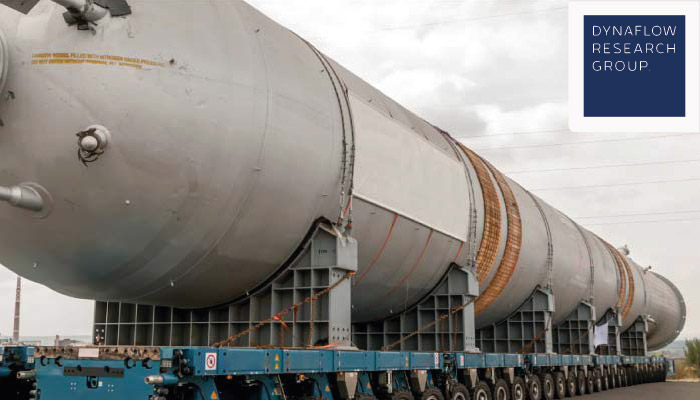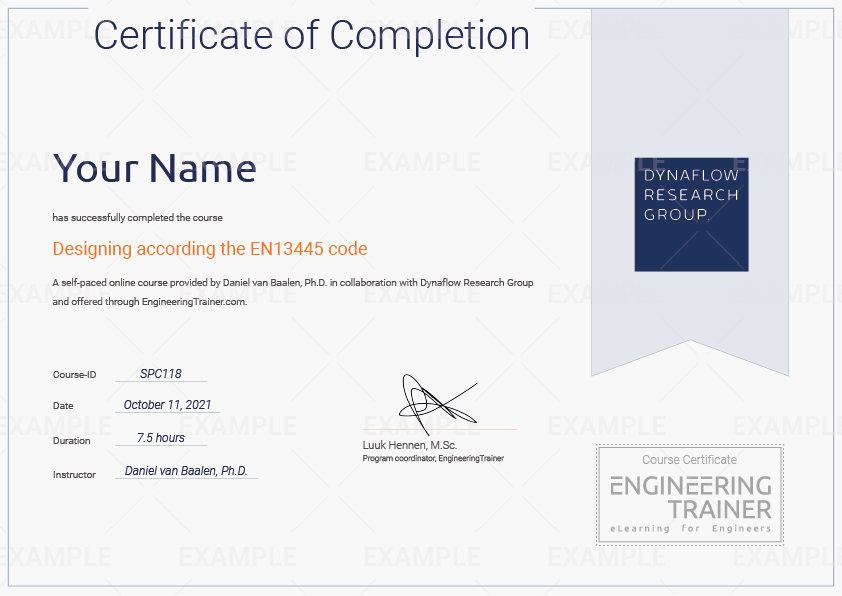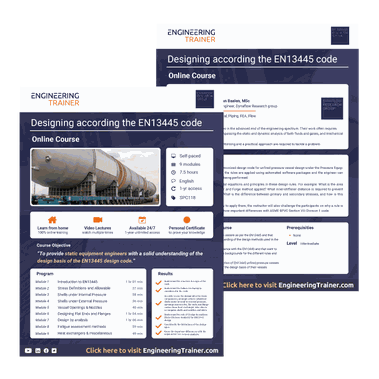
Designing according to the EN13445 code
899.00 €
/ user
e-Hybrid for teams (min. 4)
9 Modules + 4 Live sessions
Daniel van Baalen, MSc
HYB118
Selected format
Course Objective
"To provide static equipment engineers with a solid understanding of the design basis of the EN13445 design code."
Learn from home
100% online training
Video Lectures by Experts
watch multiple times
Available 24/7
1-year unlimited access
PDH Hours qualified course
Read more here
About the course
e-Hybrid
4 live sessions
9 Modules
Custom
English
HYB118
The EN13445 design code is the harmonized design code for unfired pressure vessel design under the Pressure Equipment Directive (2014/68/EU). Often the rules are applied using automated software packages and the engineer can lose the overview of the calculation being performed.
This course explains the fundamental equations and principles in these design rules. For example: What is the area replacement rule? How is the Taylor and Forge method applied? What inner-stiffener distance is required to prevent collapse under vacuum, and why? What is the difference between primary and secondary stresses, and how is this evaluated in the code?
Next to explaining the rules and how to apply them, the instructor will also challenge the participants on why a rule is formulated in a particular way and show important differences with ASME BPVC Section VIII Division 1 code.
The course consists of 9 online, self-paced learning modules and 4 interactive, online live sessions with the instructor. Recordings of the live sessions and related training content are provided through our online portal.
Meet your instructor
Program & Details
-
Welcome to the course
-
Your instructors
-
How to use this course
-
Personal Certificate requirements
-
Introduction
-
Scope
-
Materials
-
Brittle failure & creep
-
Module 1, Exercise 1
-
Welds and discontinuities
-
Fatigue analysis
-
Wall thickness & corrosion
-
Hydrostatic test pressure
-
Intro: Stress definitions
-
Stress/Strain relationships
-
Stress/Strain relationships
-
Load cases
-
Maximum design stress
-
Module 2, Exercise 1
-
Discussion of submitted user questions
-
Live Q&A
-
Discussion of technical challenges customer
-
Additional examples & tutorials by the instructor
-
Intro: Shell design
-
Cylindrical shells
-
Spherical shells
-
Formed ends
-
Cones and conical sections
-
Cone to cylinder transition
-
Module 3, Exercise 1
-
Intro: Shell design
-
Cylindrical shells
-
Cylinder with Stiffeners
-
Module 4, Exercise 1
-
Cones
-
Shell ends
-
Intro: Vessel openings
-
Pressure area method
-
Analysis of a set-on nozzle
-
Adjacent openings
-
Special cases
-
Module 5, Exercise 1
-
Discussion of submitted user questions
-
Live Q&A
-
Discussion of technical challenges customer
-
Additional examples & tutorials by the instructor
-
Intro: Flat ends & flanges
-
Clause 10: Flat Ends
-
Flange types
-
Taylor-Forge flange check
-
Pressure rating method
-
Flange analysis
-
Module 6, Exercise 1
-
Intro design-by-analysis
-
What is design-by-analysis?
-
The equivalent stress
-
Module 7, Exercise 1
-
Stress Decomposition
-
Stress assessment
-
Stress decomposition
-
Instability & Buckling
-
Module 7, Exercise 2
-
Discussion of submitted user questions
-
Live Q&A
-
Discussion of technical challenges customer
-
Additional examples & tutorials by the instructor
-
Intro: Fatigue assessment
-
Simplified fatigue check
-
Detailed fatigue assesment
-
Fatigue safety factor
-
Comparing fatigue checks
-
Module 8, Exercise 1
-
Intro: Heat exchangers
-
Types of heat exchagers
-
Tubesheet thickness
-
Module 9, Exercise 1
-
Alternative methodes
-
Bellows & expansion joints
-
Rectangular vessels
-
Applied forces & moments
-
Lifting lugs
-
Saddle supports
-
Supports
-
Discussion of submitted user questions
-
Live Q&A
-
Discussion of technical challenges customer
-
Additional examples & tutorials by the instructor
-
Congratulations
-
Course evaluation survey
-
Your Personal Certificate
-
Rate this course
-
Related resources & follow up
Results
After this course, you...
-
understand the structure & scope of the code,
-
understand the failure mechanisms considered in the code,
-
are able to use the design rules for many components, amongst others cylindrical shells under internal & external pressure, openings and nozzles, flat ends and flange connections, heat exchanger tube sheets, rectangular shells and saddles and skirts,
-
understand the role of Design by analysis (Finite Element Analysis) for EN13445 design,
-
can identify the limitations of the design rules,
-
know the important differences with the ASME BPVC VIII-1.
Who should attend this course:
-
Those required to design pressure vessels as per the EN13445 and that want a solid overview and understanding of the design methods used in the code.
-
Engineers that already have experience with the EN13445 and that want to improve their understanding of the backgrounds for the different rules and methods applied in the code.
-
Technicians involved in the production of EN13445 unfired pressure vessels that want a solid understanding of the design basis of their vessels.
Prerequisites: None
Level: Foundations
Self-paced modules & live sessions
This course consists of 9 self-learning modules combined with 4 instructor-led group sessions (online) in which participants can ask questions to the instructor which are be discussed, as well as questions submitted in the self-learning modules. After each live session the recording of that session, used slides and exercise documents are made available to participants on the learning portal.
You receive 1-year unlimited access to the course. This allows you to watch content again if this is beneficial for your daily work activities.
The live sessions are scheduled together with the customer and are private for their team only.
After the course participants receive 1-year unlimited access to all course content including recordings of the live sessions. This allows them to watch videos or recording live sessions again whenever required to refresh knowledge for daily work activities.
A personal digital certificate will be made available to each participant upon full attendance and completion of the self-learning modules.
Example Certificate:

FAQ
Self-paced learning modules
The modules consist of:
-
Video lectures
-
Video demonstrations
-
PDF exercises
-
Exercise answers by demonstrations (video)
-
Multiple choice questions that help understand technical concepts
Live sessions
Group live sessions are provided to your team by means of online calls with the instructor. Recordings of the live sessions and related training content are provided through our online portal. During each session, participants can ask questions to the instructor which are be discussed as well as questions submitted in the self-learning modules. The live sessions allow teams to discuss specific challenges with the instructor with respect to the training topics.
After each live session the recording of that session, used slides and exercise documents are made available to participants to view again.
Exercise files can be downloaded, these can include .pdf files with the exercise questions, software models or other file types. Videos will not be available for download, but can be accessed directly with your account on the portal. If slides are used in the videos or live sessions these can be viewed separately as well through the portal, but are not available for download. You receive 12-months unlimited access to the course. This allows you to watch content again if this is beneficial for your work projects.
Yes, interactive Q&A sessions are included in this course that allow you to interact with the instructor and ask questions. Additionally, questions can be submitted in the learning portal by the participants which are addressed in the live sessions.
No software is used for this course or will be distributed.
Selected course format
Self-paced
€ 699
/ user- Self-learning modules
- Online discussion forum
- Live sessions with instructor
- 1-year access
- For individual learning
e-Hybrid
€ 899
/ user- Self-learning modules
- Online discussion forum
-
Live sessions with instructor
- 1-year access
- For teams (min. 4)



![[SPC008] Designing according the EN13480 code](/web/image/131615/ILL008-course-image.minAI-%28379x216%29-logo.jpg)
![[SPC140] Designing according the ASME BPVC VIII-1 code](/web/image/131854/ILL140-course-image.minAI-%28379x216%29-logo.jpg)
![[SPC141] Working with ASME VIII-2 chapter 5: “Design by Analysis”](/web/image/131952/SPC141-course-image.minAI-%28379x216%29-logo.jpg)
![[SPC030] Pressure Equipment Directive (2014/68/EU)](/web/image/209902/SPC030-course-image.minAI-%28379x216%29-orange-logo.jpg)
